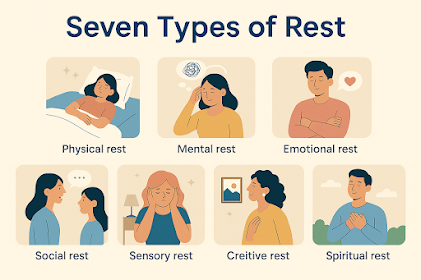Why You're Still Tired: The Missing Puzzle of Rest
“Doctor, I’m doing everything right — eating clean, exercising, sleeping 7–8 hours — but I still feel exhausted.”
I’ve heard some version of this complaint in therapy rooms, classrooms, and even among colleagues who appear to “have it all together.” In truth, this exhaustion isn’t due to laziness, weakness, or lack of sleep. It stems from a deeper depletion — one that most of us don’t know how to name.
That’s because we have misunderstood rest. We’ve mistaken sleep for rest, and in doing so, we’ve robbed ourselves of the full spectrum of recovery that our body, brain, and spirit actually need.
The Problem: Rest Is Not Just Sleep
We live in a society that glamorizes productivity and glorifies hustle. In such a culture, rest is often framed as laziness, a reward for hard work, or something optional. Even those of us who try to sleep better, eat healthier, and meditate regularly can still feel inexplicably drained.
This insight became clearer to me after coming across the work of Dr. Saundra Dalton-Smith, who identified seven types of rest — each corresponding to a unique form of energy that we expend in daily life.
This model, when seen through the lens of neurobiology and mental health, makes perfect sense. Because different parts of our nervous system get exhausted in different ways — and each one needs a different form of recovery.
Let’s explore them in depth.
1. Physical Rest: The Body’s Reboot
We usually equate rest with this domain — lying down, sleeping, or maybe taking a nap. But physical rest also includes active restoration like stretching, slow yoga, deep breathing, or even getting a massage. The point is to shift from tension to softness.
Think of your muscles, joints, and bones as a support system that works overtime. Overuse — even with good intention, like over-exercising — without proper rest can lead to chronic pain, fatigue, and mental burnout.
2. Mental Rest: Uncluttering the Mind
Mental rest is often the most ignored. In a hyperconnected world, we are constantly thinking, planning, analyzing, scrolling, and multitasking. The prefrontal cortex, our “thinking brain,” gets overloaded.
We need to learn the art of mental pausing — scheduled breaks, quiet walks, journaling, or low-effort tasks like watering plants or folding clothes.
3. Emotional Rest: Permission to Be Real
We live in a world that constantly demands emotional regulation. We smile through pain, suppress tears, and tell people “I’m fine” when we’re not. Over time, this leads to emotional exhaustion, often mistaken for general fatigue or irritability.
Emotional rest means expressing your true feelings without fear of judgment. It’s about having safe relationships where you don’t have to “perform.” It’s also about setting emotional boundaries — saying no, unplugging, or giving yourself space.
4. Social Rest: From People-Pleasing to People-Nourishing
Not all social interactions are nourishing. Some people leave you more drained than before the conversation started. Social rest involves stepping away from relationships that are performative or draining, and moving toward those that are restorative.
You don’t have to isolate yourself. You just need to prioritize authentic connection over social obligations.
This includes saying no to constant notifications, silencing group chats, or taking a break from being "available" 24/7.
5. Sensory Rest: Reclaiming Silence in a Noisy World
We live in an era of continuous input — screens, music, advertisements, traffic, messages, vibrations. Most of us are in a state of low-grade sensory overload.
Sensory rest is about creating intentional silence and stillness — dimming lights, reducing screen time, sitting in quiet nature, even closing your eyes and listening to your breath.
6. Creative Rest: Reawakening Wonder
Have you ever looked at a sunset or a painting and felt completely still inside? That’s creative rest — engaging in experiences that awaken awe, novelty, and beauty.
It doesn’t mean producing something. It means being inspired without pressure. Walks in nature, visits to an art gallery, reading poetry, or listening to music that moves you — all these help refill your creative reserves.
7. Spiritual Rest: Remembering What Matters
This is the deepest layer of rest — the one that brings alignment with your values, beliefs, and sense of purpose. It doesn’t have to be religious. It’s about connection — to nature, humanity, a cause, or a higher self.
Spiritual rest involves practices like prayer, meditation, volunteering, journaling about purpose, or simply pausing to feel awe.
A Simple Daily Practice: Ask the Right Question
The most powerful tool I offer to clients, students, and even myself is this question:
“What kind of tired am I today?”
It cuts through confusion. It brings clarity. And it honors the layered reality of being human.
Once you identify the kind of rest you truly need, you can respond with intention. The answer is rarely “sleep more.” Often, it’s “spend time with someone who gets me,” or “switch off my phone for an hour,” or “watch the clouds move for ten quiet minutes.”
Reframing Rest: Not a Pause from Life — A Return to Life
Rest is not a retreat. It’s a reset. It’s not about doing less — it’s about doing what heals.
When we treat rest as an afterthought, we eventually pay for it — in burnout, illness, or emotional numbness. But when we embrace it as an integral rhythm of living, we restore ourselves.
We don’t ask a plant to grow without sunlight. Why expect ourselves to thrive without true rest?



Comments
Post a Comment